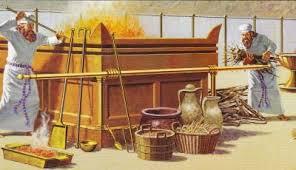The Offerings from the Priests Perspective
6:8 to 7:38
What was it like to be a priest of Isra’el? Imagine waking up every day looking forward to splashing blood at the base of the bronze altar, washing bladders, and coming home every night smelling like smoke! We know from rabbinic writings that there were more than enough priests to go around and to share equally in the tremendous burden of the daily ministry. In the Soncino Edition of the English translation of the Babylonian Talmud, we find some helpful information among the explanatory notes to Yoma Chapter 11. We read, “There were twenty-four divisions of the priests. Each division consisted of four to nine families. Every week another division served in the Sanctuary, being relieved on the Sabbath. During the week they distributed the service among the families. Any one among the family whose turn came on the day could for example, if he so desired, remove the ashes from the bronze altar.”

This indicates that there were a lot of priests among whom the work was distributed. There was enough work, for example, for only one priest to be assigned to take out the ashes, one priest to clean the bronze altar, one priest to keep the wood piles built up . . . well, you get the picture. In other words, there were more priests than ministry opportunities. This information was not in this portion, but is helpful nonetheless. We can only assume that many of the basic practices of the priests were performed in the same way during the First Temple period (Solomon’s Temple), and also during the Second Temple period (Herod’s Temple). A good example of this can be seen in the commentary on The Life of Christ, to see link click Ak – The Birth of John the Baptist Foretold).58
As we study the Torah’s complex mitzvot of sacrifice, we can easily “lose the forest for the trees.” The Torah offers great detail regarding what and how to sacrifice, but it does not grant us much in regard to their meaning and significance. Just reading the sacrificial mitzvot can seem mechanical and dull. It is sometimes difficult to see why those mitzvot should even be sacred scripture. This feeling of disconnect from the sacrificial passages is normal. It results from our unfamiliarity with the entire milieu of the Tabernacle worship system. The Torah tends to take it for granted that the larger conceptual and spiritual significance to the rituals it reports on are well known and assumed. For the most part, only the procedures are written down.
If we could see the sacrificial system service in all its glory, splendor, and elaborate choreography, we would be surprised at the exalted spiritual quality of the experience. In addition to the sacrificial rituals, we would hear the prayers of the worshipers, the confessions of the contrite, the blessings of the priesthood, and the songs of the psalms played and sung by the Levites. We would be surprised to discover a worship service not entirely unlike the contemporary Messianic congregation’s service, which is descended directly from the Tabernacle service. The synagogue prayer services are modeled after the Temple’s sacrificial service. After the destruction of the Temple in 70 AD, only the prayer services continued. The early Catholic church modeled much of her mass after the synagogue. This in turn gave rise to the protestant forms of worship services with which the modern believer is familiar. Thus, there is a line of communication between even the most contemporary Sunday morning service and the ancient Tabernacle sacrifices.
As believers, we understand well that Messiah is our ultimate sacrifice and High Priest. But this does not mean that we should neglect the mitzvot of sacrifice or the discipline of prayer which continues to memorialize the sacrifices. Rather, we should be all the more eager to study and participate because we have had the personal experience of sacrifice. We have all participated in the sacrifice of Yeshua Messiah.59



Leave A Comment